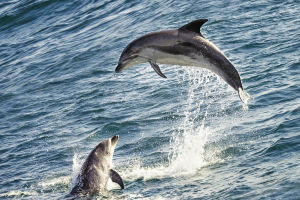In the vast expanse of the ocean, a community of graceful and intelligent beings captivates with their lively demeanor and amiable nature.
They are the ocean's emissaries—dolphins.
This article embarks on a journey to uncover the enchanting world of dolphins, delving into their ecological behaviors and interactions with humans, revealing the unique allure of these captivating creatures.
1. Ecological Behaviors of Dolphins
Dolphins, as marine mammals, belong to the order Cetaceans, encompassing numerous species. Among them, common dolphins, spotted dolphins, killer whales, and more grace our oceans.
Feeding primarily on fish and squid, dolphins boast sophisticated hearing and sonar systems, enabling precise prey localization. Their agility and prowess in swimming, characterized by swift maneuvers, leaps, and rolls, evoke boundless joy and astonishment.
Dolphins predominantly thrive in social groups, fostering close-knit social structures. Communication amongst them involves an array of sounds—from whistles and chirps to clicks—comprising a rich language of interaction.
These dolphin pods exhibit distinct territorial tendencies, establishing specific marine domains for habitation and reproduction.
2. Interaction with Humans
The historical interaction between humans and dolphins is imbued with mutual fascination. Revered across cultures as symbols of good fortune and wisdom, dolphins have long captured human imagination. In ancient Greek mythology, dolphins were revered as the steeds of Poseidon, the god of the sea.
Modern scientific inquiry confirms the cognitive acumen and social complexity of dolphins. With highly developed brains akin to humans, dolphins exhibit remarkable intelligence, manifesting traits such as self-awareness, emotional sensitivity, and social learning.
Their affable disposition and curiosity toward humans have sparked collaborations in various spheres, including marine park exhibitions and scientific research endeavors.
3. Dolphin Conservation and Challenges
Despite their adoration, dolphins confront an array of threats in their marine habitat. Pollution, overfishing, and ecological disruption jeopardize their survival. Plastic pollution, in particular, poses a grave menace, disrupting marine ecosystems and imperiling dolphins through ingestion and entanglement.
Human activities further exacerbate dolphin vulnerability. Large-scale fishing operations encroach upon dolphin habitats, while fishing gear, such as nets, poses inadvertent hazards. Recreational pursuits in dolphin habitats, though well-intentioned, may induce disturbance and harm.
To safeguard dolphins, concerted global efforts are imperative. Establishing marine sanctuaries, bolstering marine conservation measures, and advocating for plastic reduction initiatives are pivotal steps.
Concurrently, raising public awareness regarding marine conservation fosters collective stewardship toward safeguarding dolphins and marine biodiversity.
Conclusion
Dolphins epitomize the allure of the oceanic realm, enchanting admirers with their grace and intelligence. Delving into their ecological dynamics, human interactions, and conservation imperatives underscores the imperative of preserving these charismatic creatures.
Let us harmonize with dolphins in our shared maritime domain, forging a path toward a sustainable future amidst the azure expanse of our oceans.


